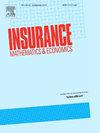Robust parameter estimation for the Lee-Carter family: A probabilistic principal component approach
IF 2.2
2区 经济学
Q2 ECONOMICS
引用次数: 0
Abstract
Although the impact of outliers on stochastic mortality modelling has been examined, previous studies on this topic focus on how outliers in the estimated time-varying indexes may be detected and/or modelled, with little attention being paid to the adverse effects of outliers on estimation robustness, particularly that pertaining to age-specific parameters. In this paper, we propose a robust estimation method for the Lee-Carter model, through a reformulation of the model into a probabilistic principal component analysis with multivariate t-distributions and an efficient expectation-maximization algorithm for implementation. The proposed method yields significantly more robust parameter estimates, while preserving the fundamental interpretation for the bilinear term in the model as the first principal component and the flexibility of pairing the estimated time-varying parameters with any appropriate time-series process. We also extend the proposed method for use with multi-population generalizations of the Lee-Carter model, allowing for a wider range of applications such as quantification of population basis risk in index-based longevity hedges. Using a combination of real and pseudo datasets, we demonstrate the superiority of the proposed method relative to conventional estimation approaches such as singular value decomposition and maximum likelihood.
李-卡特族的鲁棒参数估计:一种概率主成分方法
虽然已经研究了异常值对随机死亡率建模的影响,但先前关于这一主题的研究主要集中在如何检测和/或建模估计时变指数中的异常值,很少关注异常值对估计稳健性的不利影响,特别是与特定年龄参数有关的不利影响。在本文中,我们通过将Lee-Carter模型重新表述为具有多元t分布的概率主成分分析和有效的期望最大化算法来提出一种稳健的估计方法。该方法显著提高了参数估计的鲁棒性,同时保留了对模型中双线性项作为第一主成分的基本解释,以及将估计的时变参数与任何适当的时间序列过程配对的灵活性。我们还扩展了所提出的方法,用于Lee-Carter模型的多种群推广,允许更广泛的应用,例如基于指数的长寿对冲中种群基础风险的量化。使用真实和伪数据集的组合,我们证明了该方法相对于传统的估计方法(如奇异值分解和最大似然)的优越性。
本文章由计算机程序翻译,如有差异,请以英文原文为准。
求助全文
约1分钟内获得全文
求助全文
来源期刊

Insurance Mathematics & Economics
管理科学-数学跨学科应用
CiteScore
3.40
自引率
15.80%
发文量
90
审稿时长
17.3 weeks
期刊介绍:
Insurance: Mathematics and Economics publishes leading research spanning all fields of actuarial science research. It appears six times per year and is the largest journal in actuarial science research around the world.
Insurance: Mathematics and Economics is an international academic journal that aims to strengthen the communication between individuals and groups who develop and apply research results in actuarial science. The journal feels a particular obligation to facilitate closer cooperation between those who conduct research in insurance mathematics and quantitative insurance economics, and practicing actuaries who are interested in the implementation of the results. To this purpose, Insurance: Mathematics and Economics publishes high-quality articles of broad international interest, concerned with either the theory of insurance mathematics and quantitative insurance economics or the inventive application of it, including empirical or experimental results. Articles that combine several of these aspects are particularly considered.
 求助内容:
求助内容: 应助结果提醒方式:
应助结果提醒方式:


